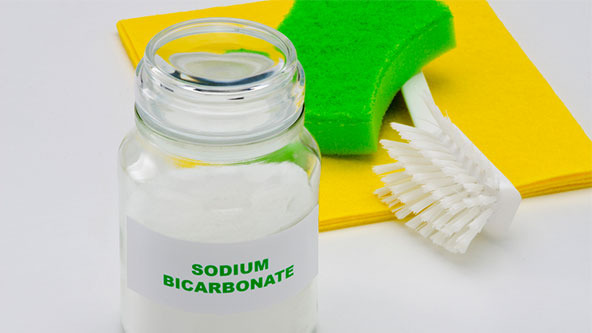Sodium bicarbonate (better known to the world as baking soda) is a soluble white powder that is crystalline but often appears as a fine powder. It’s odorless, non-combustible and reacts with acids to release carbon dioxide gas and heat.
The Versatility of Sodium Bicarbonate
Sodium bicarbonate serves a variety of purposes, ranging from household uses such as baking and cleaning, to treating minor medical ailments like sunburn and insect bites. Sodium bicarbonate has many applications in the workplace as well, including being used in fire extinguishers or in an agricultural setting as a fungicide to combat the growth of fungus in agricultural applications.
Potential Health Hazards from Sodium Bicarbonate
While sodium bicarbonate is generally not considered to be amongst the most harmful of chemicals, exposure to large amounts may result in some adverse health effects, such as:
- Coughing and sneezing if a high concentration of dust has been inhaled
- Gastrointestinal irritation can occur if large amounts have been ingested
- Mild irritation, such as redness and slight pain, may result from eye contact
- In dry form, it’s typically non-irritating to intact skin; however, it can cause irritation to damaged skin when moisture is present
Safety Precautions When Handling Sodium Bicarbonate
Respiratory
If sodium bicarbonate dust in the worker’s breathing zone can’t be controlled with ventilation or other engineering means, workers should wear respirators or dust masks approved by a certification organization, such as The National Institute for Occupational Safety and Health (NIOSH), for protection against this chemical.
Skin
Protective gloves and clothing should be worn.
Eyes
Since sodium bicarbonate is most-often seen in a powder-like state, chemical safety goggles should be worn and an area to wash eyes and skin should be located in the work area. If this chemical gets into a worker’s eyes, it can cause mild to moderate irritation.
Managing Exposure to Sodium Bicarbonate
Even though sodium bicarbonate is relatively safe compared to other chemicals in the workplace, as with any chemical, all unnecessary exposure should be avoided. In the event exposure occurs, the following steps should be taken:
1) Eye Contact
Flush eyes with plenty of water and seek medical attention if irritation occurs.
2) Skin Contact
Wash skin with plenty of soap and water and seek medical attention if irritation occurs.
3) Inhalation
Individual should be removed from exposure and immediately moved to an area with fresh air. Seek medical attention immediately if any breathing difficulty occurs.
4) Ingestion
Drink plenty of water and seek medical attention if discomfort persists.
Handling Sodium Bicarbonate Spills
If sodium bicarbonate spills, it can be recovered and re-used if contamination hasn’t occurred. Vacuuming or wet sweeping are recommended to avoid dispersing dust. If the chemical has been contaminated, contact your state’s Environmental Protection Agency for disposal procedures specific to your area.
Proper Sodium Bicarbonate Storage
Sodium bicarbonate should be stored in a tightly closed container and placed in a cool, dry, well-ventilated area. Keep away from acids, excessive heat and moisture. For more information on sodium bicarbonate and other chemicals, browse our extensive database of SDS information.
VelocityEHS Can Help!
Looking for chemical hazard and safety information? Visit our VelocityEHS SDS Search page to quickly access safety data sheets (SDS) for the chemicals in your workplace. While you’re there, check out the Chemical Management capabilities of our Safety Solution, part of the VelocityEHS Accelerate® Platform. Our Chemical Management software capabilities will help you simplify the management of hazardous chemicals in your workplace including employee right-to-know access to SDSs from any mobile device, detailed workplace chemical inventory tracking, container labeling, and OSHA/EPA regulatory reporting, and much more!
Request a Demo today to see how easy GHS/HazCom compliance can be!
